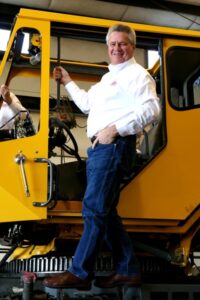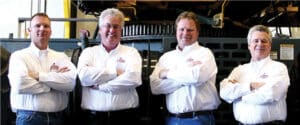This article appeared in the October 2012 Issue of American Crane & Transport Magazine, written by Lindsey Anderson. You can view the original article here.

Ron Williams didn’t purposely set out to get into the business of repairing damaged cranes. In fact, it was another company’s shoddy work that caused the chairman and chief executive officer of WHECO Corp. to consider getting into the repair industry.
WHECO was originally a division of another service business that Williams started in 1968 in a rural Washington community. In 1978, WHECO was spun off and incorporated. At that time, its services included manufacturing specialty construction and transportation equipment, providing hydraulic repair services, and being a U.S. Department of Defense contractor that provided re-manufacturing services on cranes and other military support equipment.
In the early 1980s, Williams was working to grow WHECO’s existing business. The company had just taken on an accident-damaged crane for a customer, but it needed structural repairs, so Williams and his team scoured the country to find a credible company that specialized in crane structural repairs. Williams had the structural repairs sent from his Washington-based facility to a company in South Florida—and when the pieces came back, Williams knew he could do better work.
“We were very disappointed in the workmanship, so we then decided that if we were seeing the best our country had to offer, we were going into the crane structural repair business,” he says. “We then purchased that crane, finished the repairs and sold it.”
With his feet wet in the proverbial crane repair business, Williams sold off the other branches of WHECO and concentrated on shaping his company into a repair and rebuild business. Williams also setup WHECO to provide additional services such as service-life extension projects and re-manufacturing of cranes, drilling equipment, oil field service equipment, and pile-driving equipment.
“We established critical company repair processes, which continue to serve us well to this day,” Williams tells ACT. “Our business model is to always provide documented, OSHA-compliant, engineered repairs, always perform top quality structural repairs that look like we have not been there, and not to perform modifications to the crane manufacturers’ original design or structural capacity ratings.”
WHECO now has five rebuild facilities strategically located within the continental U.S., plus a crane maintenance center on Kwajalein, The Marshall Islands. It also has provided specialized field service repairs in Alaska, Hawaii, Europe, Asia, Africa, and South America.
What are the biggest challenges in repairing damaged cranes and equipment?
There are really two key challenges that we consistently face. First, while there is not much that we haven’t seen, each repair is still unique and requires a detailed survey to develop a specific scope of work and plan. Second is to educate the customer to understand what we are doing and have them buy into our process. We are very proud that in over 32 years of providing structural repairs, we have never experienced a failure or been a defendant in a law suit. It’s a great track record.
How does WHECO approach whether a crane is fixable or not?
Most anything is repairable, but we always want to ensure that a repair will be safe, compliant, and time- and cost-effective. WHECO always checks for the price and availability of replacement OEM parts as part of its process of deciding whether or not to fix or replace a crane or specific component. And while you would generally assume that if the cost of purchasing a replacement component is less expensive than repairing it, you would opt to purchase the part or component. In most cases we would agree. However, if there is a long lead time to get the part causing the crane to be out of revenue-generating service for an extended period of time, then a repair, even a more costly one, may make economic sense. When you are considering repair versus replace, you have to always consider the cost of downtime.
For your customers, what are the biggest issues in repairing an accident-damaged crane?
A common issue is their concern with compliance. Unfortunately, many customers are not familiar with OSHA and ANSI standards and do not know that third-party repair services are provided for in these standards and regulations. They often receive wrong and misleading information from the manufacturers and their dealers. It’s a constant battle, but we are slowly changing the paradigm. Our relationship with Manitowoc CraneCARE as an approved structural repair and restoration services provider has helped to endorse structural repairs for cranes.
Why are manufacturers resistant to structural repairs? How do you counter this resistance?
There are two things at work here. First, manufacturers are in the business of selling new cranes and replacement parts. So it stands to reason that they want to protect the integrity of their aftermarket business. Second, they have never really ever been challenged to think about structural repair as a value-added service to their customers. WHECO has been very successful at educating crane owners on the value and benefits of structural repairs. We counter resistance with education and providing the truth about what can and cannot be done. We also work every day to build relationships and bridges with the manufacturers in an effort to help them to better understand the value of our services to them and their customers.
What is the nature of your agreement/relationship with Manitowoc CraneCARE?
This past year, we became an endorsed provider of structural repair and restoration services for Manitowoc crane products. Essentially, Manitowoc has set up a special engineering group that we work with on structural repair projects. We work together to establish protocol and processes, and submit work that will receive a Manitowoc approval. The Manitowoc endorsement provides another layer of assurance that adds value for the customer. Our successful business model has provided WHECO the opportunity to work for all the major crane manufacturers as an independent service provider upon occasion, and has led to the development of our current authorized service provider relationship with Manitowoc. As well, we are always open to working with the other crane manufacturers to bring our value added services to their customers.

WHECO Ownership left to right: Mark Williams, Dave Wood, Jeff Williams, Ron Williams
What is it about this business that keeps you engaged?
Successfully meeting and completing the challenge of each and every job, all of which are unique. The success of WHECO is dependent on its ability to think out of the box, while providing cost effective ways to perform each repair without compromise to safety, service life, or performance. All of these must be performed in the minimum amount of time possible to minimize downtime and loss of revenue to the crane owner. Additionally, the costs of repairs must be minimized to wrap the complete job in a value-added package. If you don’t benchmark traditional repair services with a proposal from WHECO, you’re simply missing out. Our goal is to help the customer get their crane back into revenue-generating service without compromise. We have no outside conflicts of interest like selling cranes or crane parts that might deter us from that goal.
What are you most proud of in your career?
I am most proud of the fact that we have broken the glass ceiling for crane structural repairs. For years, manufacturers preached that welded structural components of cranes that were damaged must be replaced. Early on, WHECO perfected the procedures to provide safe and cost-effective structural repairs and re-manufactured crane components with minimal downtime. Our core business has taken structural repair from “behind the barn” and into the forefront, which WHECO has made into a legitimate business based on honesty and commitment to provide crane structural repairs without compromise.
What do you like to do when you are not working at one of WHECO’s shops?
I enjoy spending time with my wife, Doreen, and with my parents, who are in their 90s, and still enjoy getting out when we can take them. My sons, Jeff and Mark, are also involved in WHECO, and I also enjoy being with them and their families. I have always enjoyed antique cars, tractors, and trucks, and therefore spend time at shows and auctions, looking for more to add to my bucket list of “to-be-restored” antique junk. I also enjoy boating and touring the U.S. to see it from the ground ILO from 35,000 feet. Add in some occasional golf and fishing, life is good!
This article appeared in the October 2012 Issue of American Crane & Transport Magazine, written by Lindsey Anderson. You can view the original article here.




